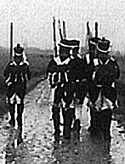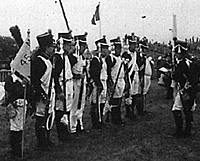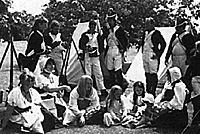
'Hanc Coronam Mastreka Declit'
The 45eme Regiment de Ligne was formed in 1643 as La Reine-Mere (The Queen Mother's) in honour of Queen Anne of Austria, Louis XIV' s regent. It's first commander was Marshal de Vitry, a former prisoner of the Bastille. The regiment fought in the myriad wars of the 17th century, and was made a Royal Regiment, La Couronne, in 1673. It continued it's valiant service throughout the 18th century, and saw its heyday in the Napoleonic period.
 Initially the 45eme served in Belgium, and then
in the Italian Campaign of 1796-99, earning a battle
honour at Lodi. The regiment was again in action in
Switzerland before forming part of Bernadotte's
Corps in the 1805-07 campaign. The 45eme distinguished itself at Austerlitz and Friedland, as
well as in several minor actions.
Initially the 45eme served in Belgium, and then
in the Italian Campaign of 1796-99, earning a battle
honour at Lodi. The regiment was again in action in
Switzerland before forming part of Bernadotte's
Corps in the 1805-07 campaign. The 45eme distinguished itself at Austerlitz and Friedland, as
well as in several minor actions.
The regiment was then divided, with 3 battalions going to Spain and the remaining one forming part of the Grande Armee's advance guard under Oudinot. The 4th battalion saw action as Essling under Lannes, assisting in the repulse of the Austrian onslaught without losing a metre of ground in the process; and at Wagram under Oudinot where they and their corps broke the Austrian centre.
In Spain, the first 3 battalions were in Victor's corps, and for the majority of their service formed part of Joseph's Household Guard. They fought in many of the Peninsular battles including Talavera, Badajoz, Fuentes de Onoro, and Vittoria; rapidly earning themselves the nickname of 'Les Invincibles'.
In 1813 the 2nd and 3rd battalions were transferred to Oudinot's corps in Saxony, where they saw action at Dresden, and it was during this battle that many of the regiment were captured. The 1st battalion continued to fight in the Peninsular at Orthez, Nivelle, St Pierre and Toulouse.
Upon Napoleon's return from exile in 1815, the regiment was reformed and joined D'Erlon's 1st corps of the Armee du Nord. At Waterloo the 45eme were unable to form square due to the adoption of an outdated formation for the corps advance. The result of this was that they were caught by Somerset's and Ponsonby's cavalry. The 45eme stood in the face of the attack and "fought like tigers" but were eventually overwhelmed, losing there beloved eagle to Sgt Ewart of the Royal Scots Greys. The few survivors later regrouped and rejoined the battle.
After the Napoleonic Wars, the 45eme was active in several colonial campaigns, Italy, and the Franco-Prussian War, winning yet another battle honour at Magenta in 1859. The First World War was another high point for the regiment, seeing it gain a further two battle honours and a Croix de Guerre with 2 palms.
In the Second World War the regiment's indomitable spirit was clearly evident in their refusal to lay down their arms upon France's capitulation. For this action the 45eme was disbanded by its conquerors, and became a part of history.
Re-enactment
 The present day 45eme is a French infantry re-enactment group, portraying the lives of soldiers and their ladies in one of the regiments of the Grand Armee. We are equally capable of
portraying the battalions in Spain or Central Europe during the 1808-09 period, the height of the Empire.
The present day 45eme is a French infantry re-enactment group, portraying the lives of soldiers and their ladies in one of the regiments of the Grand Armee. We are equally capable of
portraying the battalions in Spain or Central Europe during the 1808-09 period, the height of the Empire.
Although a fairly new re-enactment regiment, we are already very active and have been recruiting strongly. Last year we represented the 45eme on the field of Waterloo, and were in action throughout the day as part of the French skirmish line. The regiment played a key role in the capture of La Haye Sainte, and led the advance of the 1995 Imperial Guard, thereby upholding the 45eme's valiant reputation.
Unit Organisation
The main body of the unit is the Fusilier company, and this is where all new recruits start in order to learn period drill and the care and use of flintlock muskets. Whether firing a volley or delivering a bayonet charge in column, it is the fusilier company that the success of the regiment depends on.
For those of a musical disposition, the regimental band of fife and drum has been formed for the forthcoming season and will provide the period musical accompaniment for all the regiments activities.
For those who aspire to something a little different, the Voltigeur company has been formed for 1996 to act a scouts and skirmishers for the regiment, and to generally annoy the British! The Grenadier company is scheduled for 1997 and will provide a niche for the stalwart veterans of the regiment. Both of these elite companies will expect high standards of their members in keeping with the tradition of flank companies.
 Off the field, the authentic camp is manned
mainly by the women and children of the regiment It
provides an insight to life on campaign and forms the
focal point of the regiment when cooking, drilling or
resting before and after battles.
Off the field, the authentic camp is manned
mainly by the women and children of the regiment It
provides an insight to life on campaign and forms the
focal point of the regiment when cooking, drilling or
resting before and after battles.
Recruitment
The regiment is mainly based in the south of England, but we welcome members from all regions. We have a sizable depot of spare uniforms and equipment, so recruits can campaign with us immediately. When you wish to acquire your own kit, we are able to make it or provide patterns, help and encouragement for the majority of items.
So if you have always longed to wear the blue habit with full regalia at the height of the Empire, to chase the British out of Spain, to defeat the despotic Kings of Europe and protect the rights of the common man, then come and join the ranks and fight to retain the freedom gained during the revolution.
VIVE L'EMPEREUR!
For further information contact;
-
Lieutenant David Prior
29 Bayley Court
Winnersh, nr. Wokingham
Berkshire. RG11 5HT
or Corporal John Chaplin
74 North Road
Parkstone
Poole, Dorset
BH14 OLZ
Back to Table of Contents -- First Empire #30
© Copyright 1996 by First Empire.
This article appears in MagWeb (Magazine Web) on the Internet World Wide Web.
Other military history articles and gaming articles are available at http://www.magweb.com